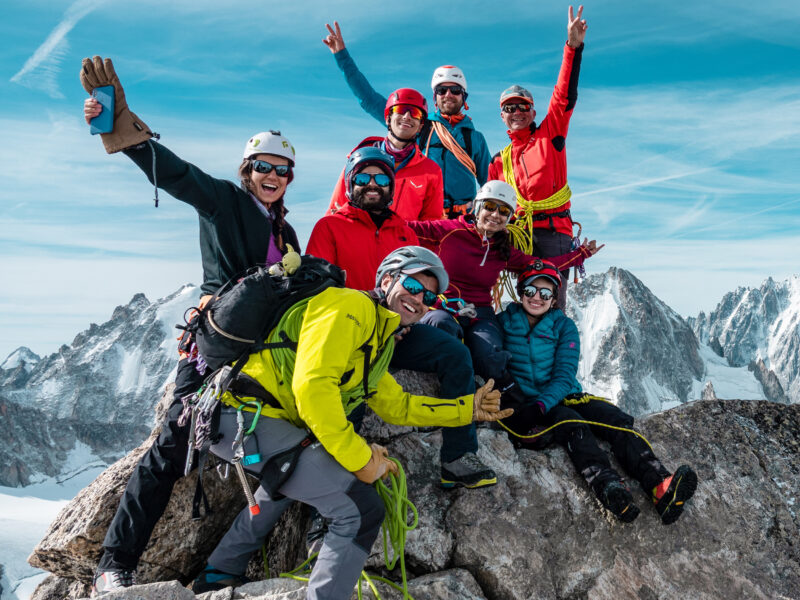BY Rami Rasamny | May 28 2020
How to Choose Upper Body Trekking Layers


“We’ve put together a short guide to helping you choose your upper body layers so that you don’t get stuck with the slowest moving and highest priced options.”
So, you’ve printed out your gear list, confidently waltzed into your local gear store, presented it to the charming young vendor eager to make a sale and then realized that there are literally hundreds of options for each item. Fear not! We’ve put together a short guide to helping you choose your upper body layers so that you don’t get stuck with the slowest moving and highest priced options.
BASE LAYER
There are two types of base layer. The first is a thin sweat absorbing base layer that can be used during warmer days and also serves as protection from the sun and a rash guard. The other type is an insulating base layer used for warmth. Both are likely to be needed on an LHO adventure but please refer to your own guidebook or gear list for specific recommendations on which one to buy for your upcoming adventure. Base layers should be fitted but not tight. We sometimes use them as pajamas so they should be comfortable enough to sleep in if necessary.
SYNTHETIC SPORTS T-SHIRTS
All T-shirts for sports and outdoor recreation should be quick dry synthetic sportswear. Cotton T-shirts should not be worn during the trekking or sports portion of an adventure because they don’t dry and will often produce a bad smell that will inevitably stink up your duffle bag even when packed away. When purchasing T-shirts make sure that they’re comfortable and loose fitting. Also pay particular attention to any rubbing in the nipple area where the brand may have printed its logo. That can be the cause of unnecessary irritation.
FLEECE LAYER
A fleece is essentially a synthetic sweater used as a middle layer when worn with everything else. This is probably your most used layer as it can often be warm when walking during the day. When purchasing a fleece layer, it’s important that the zipper goes all the way down enabling you to open the fleece fully without having to take it off.

“The shell jacket is the waterproof and windproof layer for your upper body.”
As with all layers that can be exposed to the sun, we recommend not purchasing anything dark in color so as not to absorb sunlight and cause you to overheat.
FLEECE GILET
This is an optional layer that we’ve found to be very helpful on our trekking and mountaineering experiences. It’s made of the same material as fleece and can be used as the main insulating layer during warmer days or as an additional warm layer in our layering system for colder weather. Although there are down jacket versions that are similar, we recommend the fleece because it serves the same purpose and takes up less space. It can also act as cushioning between your back and your day pack.
DOWN JACKETS
This is the warmest layer in your arsenal and great for the outdoors because it takes up very little space when packed into a day pack or duffle bag. The warmth of the down jacket depends on the number of “fills”, that is number of feathers or synthetic fibers per compartment. For most LHO experiences, 700 fills and above is enough but it’s best to refer to the guidebook or your gear list for specific recommendations. We optionally recommend getting a down jacket with a hood and to avoid purchasing dark colors.
SHELL JACKET (WINDBREAKER RAIN JACKET)
The shell jacket is the waterproof and windproof layer for your upper body. It should be free from any internal insulating layers or insulating layers should be removable because it is possible to be walking under the rain in warm weather. When purchasing this layer make sure it is large enough to fit over your down jacket and fleece when worn together. Your shell jacket must include a hood and we don’t recommend purchasing black or dark colors. Ensure that the vendor shows you the label indicating that it is waterproof.
About The Author
Rami Rasamny is the founder of Life Happens Outdoors, a premium adventure travel community dedicated to transforming lives through curated outdoor experiences. A mountaineer and entrepreneur, Rami has led teams on some of the world’s most challenging peaks, from the Alps to the Himalayas. His mission is to make adventure accessible, transformative, and safe for all who seek to push their limits and Come Back Different.
About Life Happens Outdoors
At Life Happens Outdoors, we believe in the power of nature to transform lives. As proud members of the Adventure Travel Trade Association (ATTA) and the World Travel & Tourism Council (WTTC), our team of certified guides and outdoor professionals is committed to the highest standards of safety, sustainability, and excellence.
Discover more about our story and mission on our Meet LHO page, or explore our curated adventures such as the Tour du Mont Blanc Trek, the Climb of Kilimanjaro, and Chasing the Northern Lights.














